Garden Questions and Answers
The Sunday Gardener receives lots of gardening questions and I am always happy to advise. Gardeners are such lovely people to correspond with and ask many interesting questions. Recently, it occurred to me that some of these questions would be interesting to other gardeners. With this in mind, I have saved the correspondence, and with the senders' consent, it is now included on these pages.
Have a browse, and if your question and answer is not here, follow this link to e-mail your enquiry and usually I respond within 7 days. Happy Gardening.
Gardening Questions and Answers on this page
Creating a new cottage garden
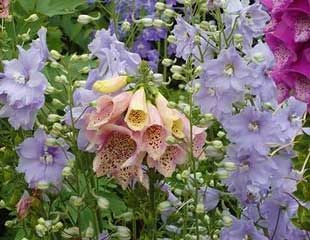
Sarah is new to gardening and E- mailed saying :
I'm a rather new gardener. I moved into a new property with a south east facing garden and hoping to install a cottage garden theme boarder. Any advice would be much appreciated about possible design layout or even when to start the process as in what time of year best.
Answer: My advice was to start with the basics and go from there. A garden facing South East should receive a fair amount of sun which is always a good starting point. This is especially so in relation to cottage garden plants such as Delphinium, Geranium, Foxgloves, Nepeta, Clematis and Wisteria, to name just a few. All are on the web-site with growing advice.
If you have moved into a new garden my advice would be to wait, at least through this summer and see what is already in the garden. Take photographs of the borders so you can identify what is already there, what you like and don’t like. If you are not sure what a plant is feel free to send it in under the Sunday garden plant identification service.
Many cottage garden plants are herbaceous, which means they come back each year but die back completely over winter, to bare earth, which is why you want to photograph them now when they have leaves and/ or flowers. Next spring there maybe little to evidence the plant until it starts to shoot up with new growth. I have a mainly herbaceous border with many cottage style plants but it would not suit everyone, as there is little or no winter interest when the plants die back, which you may want to think about. It is also higher in maintenance and to reduce the maintenance you can mix cottage style plants with shrubs for all round interest.
The one basic rule is "right place right plant". This means that plants have preferred growing conditions and these needs to be taken into account when planting up a garden.
You need to map the sun in your garden so that plants which require full sun get it, those which like dappled shade or part sun are planted in a different part of the garden.
You need to consider your soil, is it heavy, light, acid or alkaline? Plant labels will say the ideal growing conditions. Unless your garden is very sheltered you need to aim for “hardy plants” which means they are frost tolerant, there is more information about frost hardiness on the web-site. Also, it is worth taking a look around your neighbour's gardens nearby to see what they are growing. You could also check the NGS which opens up local gardens for charity and see if there are gardens open near you to look at their gardens, and have a chat, gardeners are always friendly and happy to share advice. This link to NGS lets you put in your post code and see what gardens are open near you.
Planning and planting clematis garden
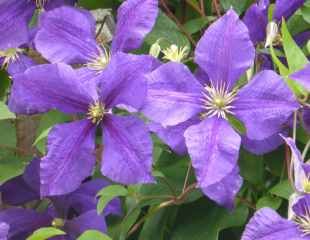
John asked for information about planning and planting a clematis Garden, and what a great idea!
Clematis are really popular climbing plants and feature a lot in gardening questions.
It was hard to know where to start on such a big topic and so I advised as follows:
With regard to your Clematis project, this sounds very exciting.
At this stage I can offer some general advice and please feel free to ask anything further as the project develops.
Most important will be where to position the clematis garden within your garden. Clematis like fertile, rich soil which is on the moist side, and it is important that neither the soil or plant dries out. Ideally Clematis like to have a cool moist root run, but still like sun on their flowers. These conditions also help to protect against Clematis wilt.
It is also important how you plant Clematis; at least 5 cms below the soil level. There is information about planting and growing Clematis and also a video about planting Clematis.
Once you have selected your spot in the garden for the clematis, you may want to enrich the soil given Clematis growing preferences and also be ready to protect the new shoots from slugs. Once established Clematis fare quite well against the slugs, but in the early stages you may need various forms of slug protection.
Finally, and possibly the best bit, choosing which Clematis to plant. This will be driven by personal preferences, but you may want to think about the size and vigour of the different types of Clematis. An extreme example would be say Clematis montana (illustrated on the Types of Clematis page,) which is very vigorous and with strong growth in ideal conditions can reach 12 metres, compared with say C. Crystal fountain, a compact variety growing to 1.8 metres. In addition to size, there is the flowering time and you can have a Clematis in flower during almost any month of the year. Again there is information on the Types of Clematis page.
Most but not all Clematis are hardy apart from C. armandii, slightly tender and C. napaulensis, which is tender.
I don’t know the position of your garden and there maybe areas which are shady. If you check out the major on line Clematis retailers they allow you to search by growing conditions and you can select Clematis which are most suited to less sunny areas. However all Clematis like good soil which is moist and benefit from a mulch, feed and watering during dry spells.
I hope this provides you with some ideas.
Planting a difficult area
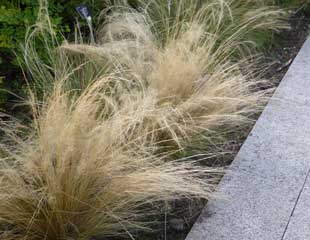
Qasim had a tricky planting area, he e-mailed saying:
I have a long narrow garden, block paved but with some plant beds on either side. I have some cordyline red stars As shown in the picture, they have been cut back and have started growing again from the base. I wanted to fill the gaps but am unsure about what to use. The middle portion of the left side is under a tree and gets a lot of weeds growing in it. What do you recommend?
Answer: What to grow depends on quite a few factors such as the amount of sun/shade/ soil condition/what sort of effect & plants you like.
The best I can do is make some suggestions.
There are a number of (ornamental ) grasses which would mix well with the Cordylines, and which are generally easy to grow and will tolerate average soil. On the same page on the web-site are some plants which look well with grasses such as Allium, Achillea, and later flowering Crocosmia. In addition, if the area is dry with decent sun for a good part of the day you could grow Lavender, and the herbs such as Rosemary, Sage and Thyme which you could also add into grasses. If you want a perennial which is fool proof plant Nepeta, and my web page 10 easy to grow flowering plants, most would probably grow there except the Astilbe which likes damp soil.
I hope this gives you some ideas. Near the tree where the soil will be very dry plant the toughest grasses, such as Deschampsia cespitosa, and perhaps the Lavender (more sun) /Cat mint (if less sun.) Whatever you plant it would be best to remove the weeds as they will inhibit any new plants trying to get established.
I cannot be sure from the image and so have assumed that the area gets are reasonable amount of sun, if that is wrong let me know as we may need to add some more shade tolerant plants into the mix.
Planting in a Gravel area
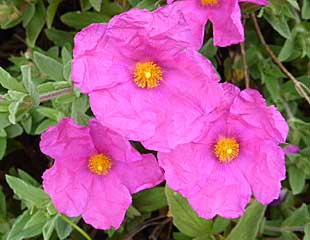
Ann asked the question: We have a gravel driveway and a low brick wall separating us from our neighbours. We would like to plant bulbs next or near to the wall but there is very little topsoil available, it is mainly gravel. Is this possible? Or could we plant something else. It is a fairly open situation with lots of sun. Thank you
Answer:
I think classic spring bulbs would struggle. Gravel is a poor environment for bulbs of this type. There are lots of plants which will grow in a gravel garden and I think my best help is to send you a link to Beth Chatto, (who sadly died recently.) Beth Chatto was an inspirational gardener who really invented gravel planting. From what you say, with the benefit of plenty of sun, there are a lot of plants you could grow. The RHS also lists suitable plants for a gravel garden and I have included this link as well.
What to plant is very much a case of personal choice and what sort of effect you want to create. I really like grasses, which will do well in a gravel garden but I appreciate they are not everyone’s cup of tea.
If you are keen on Bulbs there are some suitable Allium and Nerine.
Very well suited to this type of planting environment are the fabulous Mediterranean style of plants, such as Lavender, Thyme, Santolina, Rosemary and Cistus (the rock rose,) all would look good together and would mix well with grasses.
Subsequently, Ann was kind enough to mail and say: Many thanks, you are amazing, the advice I had concerning gravel drive was great. The thyme plants are thriving!!! Thank you.
Fickle Wisteria
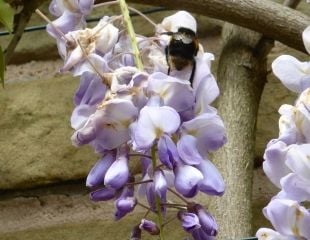
Sophie wanted to know about a Wisteria which had not flowered.
Sophie asked me what to do about her Wisteria, which was growing in a container and refused to flower. How to get my Wisteria to flower is a much asked question and thorn in the gardening side. Wisteria can be fickle. There is a good deal of information on the How to Grow Wisteria Page and a video about pruning. Usually failure to prune is the culprit and cause of Wisteria lacking flowers but on this occasion, it was the container.
You can grow Wisteria in containers, and many do successfully. However, if a Wisteria is not flowering when growing in a container, it is worth re- planting it in the ground before giving up hope. Any plant grown in a container has restricted growth, and will dry out more quickly. A Wisteria which is dry in July and August, especially an immature plant, may struggle to flower. I suggested to Sophie to plant it in the ground out of the container, and the next year it did indeed flower.
Pruning Cotinus

Winnie wanted to know the best way of Pruning Cotinus and when this should be done.
Smoke bush, Cotinus, is a lovely shrub and this year (2018) with the very hot weather, they have done particularly well producing lots of flowers, or "smoke".
Generally, Cotinus does not require pruning imply a light prune in late winter/early spring to remove any dead, spindly or congested branches. As such Cotinus is a shrub which can be grown without any real attention or maintenance. However, I guess you have asked the question because you want to prune it, perhaps it has become too large or is overhanging a neighbouring shrub/plant.
In that event you should prune in late winter/early spring. Cotinus can be hard pruned, even coppiced, but only when it is well established and hard pruning tends to produce larger leaves and less flowers, at least for the first year. It is a very tough shrub and I have seen one badly massacred, pruned very severely and it came back after 2 seasons.
I would wait until next season late winter so around Feb/March time and then prune to suit your requirements. If I can help further please do drop me another mail.
Pruning Buddleja
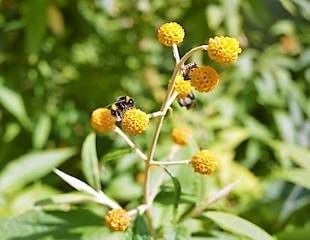
Ann asked about pruning Buddleja
Questions: I have a couple of Buddleia globosa which are more like trees; they have been pruned but are huge. Could I possibly cut them back hard to rejuvenate them, and if so could I start now? I wouldn't want to lose them, but I want to give them a new lease of life.
This type of Buddleia is pruning group 2 which means it is pruned immediately after flowering. If pruned later in the year flowering can be reduced for the next season. I assume that it has now finished flowering, so now (August) would be the right time of year to prune it. If it is still flowering, and things vary from season to season and in different parts of the country, it is best to wait until it has finished flowering.
I have never tried hard pruning this shrub, and when in doubt it is usually best to stage the rejuvenation over a period of time. I would recommend cutting out about a third of the stems, either to a side shoot or to ground level. Some flowers will be lost the following season but after that you prune again in the same way next year. Over time you will reduce the size of the shrub, checking its growth each year, without the risk of it being adversely affected by the pruning.
What's this plant?
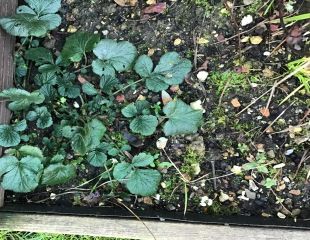
I get a lot of requests to the web site to identify plants and I am always happy to help when I can. JW e mailed asking me to identify this and unfortunately I could as it is Geum urbanum, an invasive weed.
It can be tricky to identify some weeds as they can look like common plants and of course this looks a lot like the perennial Geum we grow but instead it is a weed and one which needs eradicating fast.
Keeping on top of weeds is not a favourite task but the more vigorous perennial weeds can really cause a problem if they get a hold. For more information and some images of weeds Beat the Weeds.
Plants for a North Facing Border
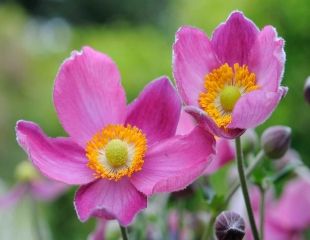
Siobhan e-mailed looking for ideas for a new North Facing border created in her garden which also needed to incorporate parts of a rockery and some plants suitable for containers.
North facing problems are more of a challenger but there are many suitable plants so here are lots of ideas in my response:
The difficulty with planting advice is that gardens are as personal as the internal decoration in your house. I offer a wide range of suggestions in the hope that some will appeal. Whatever you decide on, it is always good to have a repeat theme in a border picking up one or two plants to be repeated along the border and to plant in 3/4/5 to avoid the border looking “dotty” .
For planting up your new border there is some information on the website on the plants for shade page.
I assume that if you are planting any shrubs in this area they would need to be compact to fit in with a rockery type theme, and there are, of course, small varieties of Rhododendrons and azaleas, if you have an acid soil or in a container. The amount of sun required varies from variety to variety and there are many offered for sale which will grow in partial shade and offer strong spring colour.
Other smaller shrubs tolerant of partial shade are Sarcococca which grows up to 1m, a winter flowering evergreen with very scented flowers. Skimmia japonica grows a little taller 1.5m also evergreen and ‘Fragrans’ has as the name suggests scented flowers. There are compact varieties of Leucothoe which has attractive foliage especially in autumn.
Plants-Although a little cliché it is still true to say, Hosta on mass can look very stylish, and there are a number which are slug resistant which look good for most of the summer.
Japanese anemones are suitable for shade and are a reliable herbaceous summer flowering perennial returning each year. The tall bell flower, Campanula persicifolia will tolerate some shade, C. alba would look good with the anemones, and some of the blue varieties are also shade tolerant; ‘ Campanula persicifolia ‘Telham Beauty’ is a nice soft shade of blue. Astilbe would be ideal and they come in many shades of red, pink, cream, and white and are another herbaceous perennial which is easy to grow.
You could mix these in You could mix these in Alchemilla Mollis which will grow anywhere, with the caveat it is, or can be, vigorous. The bright lime green of the leaves and flowers look good contrasted with dark foliage, many of the dark leaved Heuchera do well in partial shade as their leaves tend to scorch in full sun.
Still looking at colour, there are a number of hardy Geraniums which will grow in partial shade and Geranium endressii has lovely magenta flowers.
If you like traditional garden favourites, there are roses specifically bred for shade, check out this link to David Austin, to which you could add some shade tolerant Clematis I grow C. Arabella in partial shade and it flowers well. Of note is Clematis terniflora which is a sweetly scented Autumn flowering Clematis, and C. fammula which is also scented, all of which would combine well with various shades of digitalis, the foxglove which loves shady spots.
For spring colour there are number Hellebores would suit, and which mix in well with Aquilegia (vulgaris is the most shade tolerant) and Pulmonaria. Traditionally, Bergenia are suggested to be planted in shady, spring borders, I really don't like or grow them but they are popular so I feel obliged to throw them in the mix! Better and much more colourful are the various Primula which like some shade and very attractive are the candelabra variety 'Harlow-Carr' ( illustrated half way down the page) which are long flowering in bold shades of red, orange, purple and yellows.
Finally I would add in Astrantia in lovely shades of pink, white and red.
I hope this gives you some ideas and I am happy to help further. If the border is on the dry side because of the tree roots, dig in organic matter before planting and a mulch will help significantly to retain water.
Nothing I have suggested is hard to grow or requires too much attention other than the roses!
Growing Wisteria in a Container
Andrew asked: I want to plant a wisteria on a south-facing wall but need to plant it in a container as the area is a paved patio. How big a container should I consider using?
I advised him that you can grow Wisteria in a container, in which event you may want to consider the eventual size and vigour of the Wisteria you select. Wisteria are very vigorous and this video (which is the one I have growing at home) in less than 10 years it has grown from a small plant to covering all the wall. From this you will appreciate the need to ensure that you plant the Wisteria into a large container and consider feeding and watering. Size wise and given the long time the Wisteria will be in the container, I would be looking at around 60 cms to give it plenty of growing room. The compost in the container may need to be supplemented with feed, but not too much or you will encourage the plant into leafy growth not flowers. Whilst Wisteria is fairly drought tolerant in a container it is more prone to drying out and will need to be watered in a dry spell.
If you look at where the Wisteria is planted in the video it is on a patio but we opted to take up a few paving slabs to plant directly into the soil which is, if you can and want to do it, a more satisfactory solution as it avoids any problems with the compost and watering. Bearing in mind the longevity of Wisteria, it will be in the container for many many years. It is not a difficult plant to grow, because it is so vigorous, although you will need to top dress from time to time and water if it is very dry, once established Wisteria is very tough.
I would still favour planting in the ground if you can. Wisteria is demanding to grow in terms of the pruning regime, which is essential to maintain flowering, and I do wonder if you want to add another factor into the mix as the main problem is getting wisteria to flower. If you plant in a container and it fails to flower, at that stage I would advise removing it and planting in the ground which can be tricky if the plant is mature and already established around the growing wires. This means the level of your container will be higher than the level of the soil making re planting in the ground difficult. I mention this as one of the Q & As to my website (see above) was in respect of a Wisteria which had not flowered when planted in a container and I advised removing it and replanting in the ground and it promptly flowered.
In short, you can grow in a container, and if you want, give it a go but be prepared to give it a little more attention, especially getting established watering more often, and to be flexible if it doesn't flower you may need to rethink.
